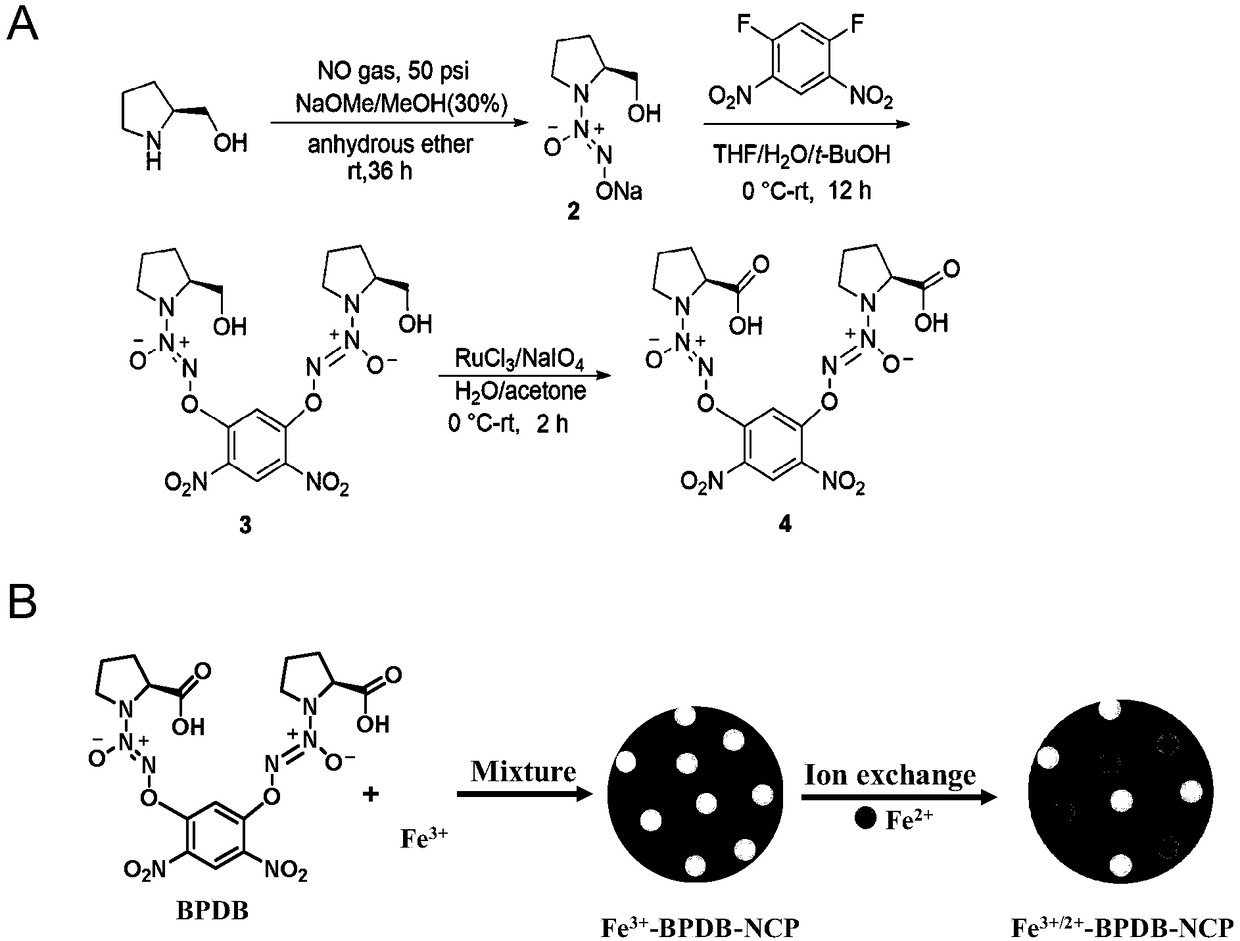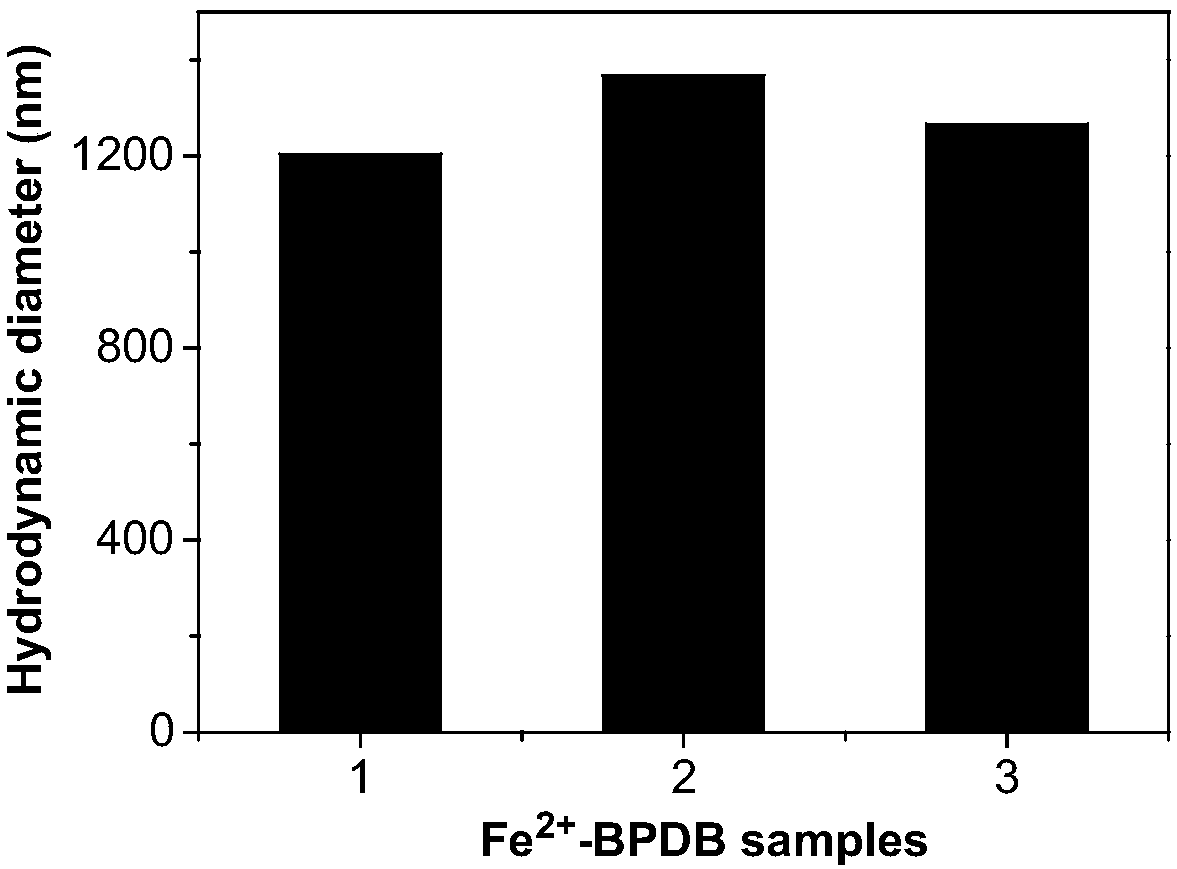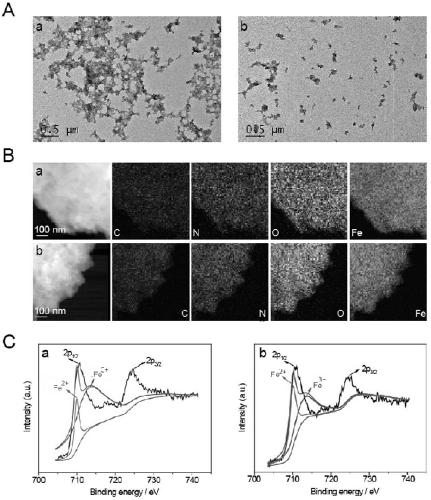Fe<3+/2+>-NO donor mixed-valence coordination polymer and application thereof
A coordination polymer and donor technology, applied in the fields of biomedical technology and nanotechnology, can solve the problems of restricting research and development and clinical application, and achieve the effect of high water solubility and stability
- Summary
- Abstract
- Description
- Claims
- Application Information
AI Technical Summary
Problems solved by technology
Method used
Image
Examples
Embodiment 1
[0039] Example 1Fe 3+ / 2+ -NO donor mixed-valent coordination polymerized nanoparticles (Fe 3+ / 2+ - Construction of BPDB-NCP)
[0040] 1. NO donor 1,5-bis(L-proline azo-O 2 -)-2,4-dinitrobenzene synthesis, the synthetic route is as follows figure 1 As shown in A.
[0041] (a) : L-(+)-prolinol is dissolved in anhydrous ether, NaOMe / MeOH is added, placed in a high-pressure reactor, and nitrogen (N 2 ) to replace the air, then introduce NO gas, and seal the reactor for 36 hours. After the reaction, anhydrous diethyl ether was added to the reaction solution, and a white solid was precipitated by stirring, which was suction filtered, washed with anhydrous diethyl ether, and dried to obtain L-(+)-prolinol azonium sodium salt, namely compound 2.
[0042] (b) : Weigh a certain amount of compound 2 and dissolve it in H 2 O, the reaction was stirred in an ice bath, and the N 2 Under protection, slowly add a tetrahydrofuran solution of 1,5-difluoro-2,4-dinitrobenzene, keep warm...
Embodiment 2
[0052] Example 2 Fe 2+ - Preparation of BPDB coordination polymer
[0053] The NO donor 1,5-bis(L-prolineazonium-O 2 -)-2,4-Dinitrobenzene (BPDB) and FeCl 2 .4H 2 O was dispersed in aqueous solution at a molar ratio of 2:15, and the pH was adjusted to 5.5 with dilute NaOH solution. Then, anhydrous methanol was added under vigorous stirring to induce Fe 2+ - Formation of BPDB particles, continue stirring for a period of time until particle growth is complete. Centrifuge and wash to obtain Fe 2+ -BPDB particles. Repeat three times, the DLS characterization results of the three samples are as follows figure 2 shown. The results showed that Fe 2+ - The hydrated particle size of BPDB is greater than 1 μm, and the required nano-scale particles cannot be further prepared.
[0054] DLS characterization:
[0055] Take freshly prepared Fe 2+ - 200 μL of BPDB coordination polymer was diluted to 3 mL with distilled water, and the hydrated particle size of the liposome prepara...
Embodiment 3
[0056] Example 3 Fe 3+ / 2+ -NO donor mixed-valent coordination polymer nanoparticles (Fe 3+ / 2+ -Characterization of BPDB-NCP)
[0057] TEM and EDS determination:
[0058] Get the freshly prepared Fe of embodiment 1 poor solvent method 3+ -BPDB-NCP and Fe 3+ / 2+ -BPDB-NCP, after diluting by a certain multiple, drop it on the copper grid, and after air-drying, characterize the morphology, size (TEM) and elemental composition (EDS) of the material on a transmission electron microscope.
[0059] XPS determination:
[0060] Prepared Fe 3+ -BPDB-NCP and Fe 3+ / 2+ -After the BPDB-NCP is freeze-dried, the powder is collected, and the iron ions on the surface of the material are characterized by an X-ray photoelectron spectrometer, and the Fe is calculated by software peak division 3+ and Fe 2+ proportion.
[0061] image 3 (A) TEM, (B) EDS and (C) XPS images of each coordination-polymerized nanoparticle prepared in Example 1 of the present invention. showed that the NO donor B...
PUM
| Property | Measurement | Unit |
|---|---|---|
| particle size | aaaaa | aaaaa |
Abstract
Description
Claims
Application Information
 Login to View More
Login to View More - R&D
- Intellectual Property
- Life Sciences
- Materials
- Tech Scout
- Unparalleled Data Quality
- Higher Quality Content
- 60% Fewer Hallucinations
Browse by: Latest US Patents, China's latest patents, Technical Efficacy Thesaurus, Application Domain, Technology Topic, Popular Technical Reports.
© 2025 PatSnap. All rights reserved.Legal|Privacy policy|Modern Slavery Act Transparency Statement|Sitemap|About US| Contact US: help@patsnap.com



